Changes of Economic Activity of the Rural Population 2001–2011
Barbara Sobolewska-Węgrzyn
Abstract
Important changes took place in rural areas as a result of economic transformation and access of the state to the European Union. The position of the rural population in the labor market has changed. The character of these changes can be determined by analyzing economic activity of the population in different temporal profiles. In the paper economic activity of the population of rural areas in 2001 and 2011 was compared. The study contains the population aged 15 and over. Categories of employed and unemployed persons composing together the labor resources and economically inactive persons were took into consideration. In the first part of the paper economic activity of the urban and rural population was compared by using, activity of employment and unemployment rates among other methods. Analysis showed that differences between economic activity of the urban and rural populations visible in the 1990s are practically non-existent today. A comparison of economic activity of the rural population in 2001 and 2011 shows that participation of economically active persons was diminished and economical inactivity increased. Amongst the economically active population the percentage of employed persons increased. Socio-economic features of employed persons have changed. We can see an increase in the level of education of employed rural inhabitants. Amongst employed persons the percentage of the population not connected with agriculture has decreased, but in industry and services it has increased. In relation to this, employment status has changed. Participation of the self-employed has diminished but participation of employees and employers has increased. However, changes in the labor supply are not accompanied by changes in demand for labor. Stimulation of local markets, mainly by enterprise development, is indispensable.
Keywords:
economical activity of the population, the rural population, development of rural area, labor marketDetails
References
Statistics
Authors
Citation rules
Licence

This work is licensed under a Creative Commons Attribution-NonCommercial-NoDerivatives 4.0 International License.


 English
English
 Język Polski
Język Polski




